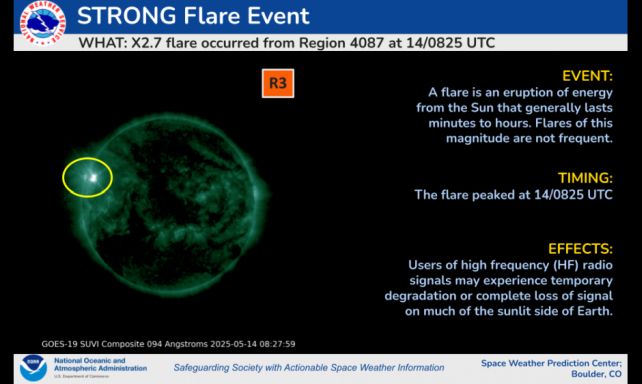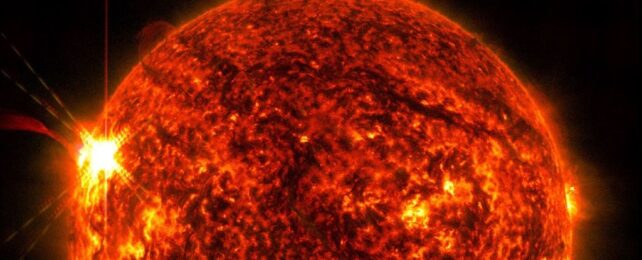On 14 May 2025, the Sun erupted with the biggest flare we've seen all year.
From the eastern limb of the Sun – that is, the left side – active sunspot region (AR) 4087 erupted in a huge, X2.7 solar flare, peaking at 08:25 UTC.
The flash of X- and gamma radiation was powerful enough to induce brief radio blackouts on Earth's dayside, but, as the NOAA reports, no further effects are expected to arrive at Earth.
Solar flares and coronal mass ejections are common when the Sun is in the most active phase of its 11-year cycle, as it is now. The most powerful flare of the current cycle was an X9.0 in October 2024.

A flare is an explosive release of energy as a result of snapping and reconnecting magnetic field lines.
A coronal mass ejection, or CME, is like a solar sneeze, hurling billions of tons of solar particles tangled up with magnetic fields out through the Solar System.
The latter is what is responsible for the more spectacular effects we see on Earth – the auroras australis and borealis, which are the result of high-speed incoming solar particles interacting with particles in Earth's atmosphere.
Flares and CMEs very often occur together, but what happens on Earth depends on which direction the eruption is pointing and how strong the eruption is.
Eruptions on the edge of the Sun tend to pass us by, but those from the middle of the Sun's disk can slam right into us, creating jaw-dropping displays of light in the sky.

When a CME slams into Earth space, we call this a geomagnetic storm, and they can be hazardous, on very rare occasions.
The particle interactions high in Earth's atmosphere can generate electrical currents that can cause surges that disrupt power grid fluctuations and disruptions. They can cause navigation, communication, and radio blackouts. They also affect objects in near-Earth space, such as aircraft and satellites.
That's not going to happen from the X2.7 flare of May 14, but we may see some exciting activity yet. AR 4087 is rowdy – in addition to the X-class flare (the most powerful flares our Sun can emit), it spat out an M5.2, an M1.2, an M7.5, and an M.46 flare on the same day; that's a class down from X flares, considered moderate in strength.

This sort of behavior is normal for the Sun during the period known as solar maximum. This is when the Sun's magnetic poles switch positions, and it is tracked by an escalating period of sunspot, flare, and CME activity.
NASA, the NOAA, and the Solar Cycle Prediction Panel announced solar maximum in October 2024; now, more than six months later, activity appears to be on the wane, but the Sun is still pretty boisterous.
The Sun rotates in a counterclockwise direction, which means AR 4087 is going to be making its way across the face of the Sun, putting it in a position more likely to aim some of its outbursts in our direction.
Let's keep our fingers crossed for clear skies and non-hazardous CMEs.
